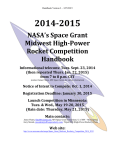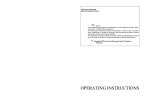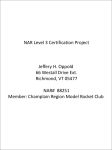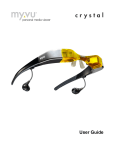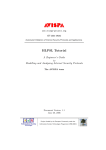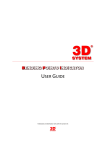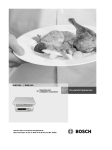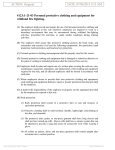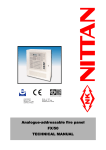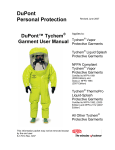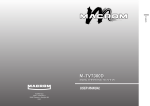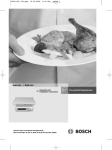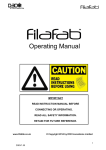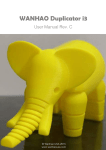Download Safety Lab Manual
Transcript
| 2013-2014 NASA Student Launch Safety Manual 1 TABLE OF CONTENTS Section 1: Introduction ................................................................................................................................. 5 1.1) Purpose ......................................................................................................................................... 5 1.2) Revision History ............................................................................................................................ 5 Section 2: Lab Workshop Safety ................................................................................................................... 6 2.1) Purpose ......................................................................................................................................... 6 2.2) General Lab Rules ......................................................................................................................... 6 Work Restrictions .................................................................................................................................. 6 Attire ..................................................................................................................................................... 6 Tool Training ......................................................................................................................................... 6 Workspace ............................................................................................................................................ 6 2.3) Personal Protection Equipment (PPE)........................................................................................... 7 Hazardous Tasks .................................................................................................................................... 7 Safety Glasses ....................................................................................................................................... 7 Hearing Protection ................................................................................................................................ 7 Protective Gloves .................................................................................................................................. 7 Face Masks ............................................................................................................................................ 8 2.4) Tool Specific Safety ....................................................................................................................... 8 Full Spectrum Laser ............................................................................................................................... 8 MakerBot Replicator 2 Desktop 3D Printer .......................................................................................... 9 Section 3: Laws and NAR/TRA Regulations ................................................................................................. 10 3.1) NAR: High Power Rocket Safety Code......................................................................................... 10 3.2) Local, State and Federal Law Compliance................................................................................... 13 Section 4: Launch Safety ............................................................................................................................. 18 4.1) Launch Day Briefing .................................................................................................................... 18 4.2) Motor Safety ............................................................................................................................... 18 Section 5: Educational Engagement Safety ................................................................................................ 19 General................................................................................................................................................ 19 Children should never work unsupervised. ........................................................................................ 19 Rocket Construction............................................................................................................................ 19 Section 6: MSDS .......................................................................................................................................... 20 | 2013-2014 NASA Student Launch Safety Manual 2 6.1) Purpose ....................................................................................................................................... 20 6.2) Material Safety Data Sheets........................................................................................................ 21 Acetone ............................................................................................................................................... 21 Acrylonitrile-Butadiene-Styrene (ABS)................................................................................................ 27 Aluminum ............................................................................................................................................ 31 Ammonium Perchlorate...................................................................................................................... 37 Black Powder....................................................................................................................................... 48 Carbon Fiber........................................................................................................................................ 53 Cellulose Fiber (Dog Barf Wadding) .................................................................................................... 59 Duct Tape ............................................................................................................................................ 63 Electrical/Masking Tape ...................................................................................................................... 70 Electric Matches .................................................................................................................................. 77 Epoxy Putty ......................................................................................................................................... 80 Foam (Last-A-Foam FR-7100) .............................................................................................................. 97 G10 Fiberglass ................................................................................................................................... 100 G12 Fiberglass ................................................................................................................................... 103 Heat Shrink Tubing ............................................................................................................................ 106 Hexanediamine (Rip stop Nylon) ...................................................................................................... 113 Hot Glue ............................................................................................................................................ 118 Instant Mix Epoxy Part A (5 Min) ...................................................................................................... 121 Instant Mix Epoxy Part B (5 Min) ...................................................................................................... 126 Isopropyl Alcohol (IPA) ...................................................................................................................... 131 Krylon Spray Paint ............................................................................................................................. 137 Loctite 680 Retaining Compound...................................................................................................... 144 Loctite 7649 Primer........................................................................................................................... 149 Leaded Solder.................................................................................................................................... 155 Nomex Fabric .................................................................................................................................... 159 Plywood............................................................................................................................................. 162 Polyethylene Terephthalate (Dacron)............................................................................................... 164 Polylactic Acid (PLA Plastic)............................................................................................................... 170 Polypropylene ................................................................................................................................... 179 | 2013-2014 NASA Student Launch Safety Manual 3 Proline (60 Minute Epoxy) ................................................................................................................ 182 Scigrip Plastic Pipe Cement ............................................................................................................... 191 Solder ................................................................................................................................................ 193 Unleaded Solder................................................................................................................................ 197 Wood Glue ........................................................................................................................................ 204 Safety Compliance Form ........................................................................................................................... 208 | 2013-2014 NASA Student Launch Safety Manual 4 SECTION 1: INTRODUCTION 1.1) PURPOSE The purpose of the safety manual is to clearly identify all rules and regulations that the team must follow. It is the safety officer’s responsibility to ensure the overall good health and safety of the team, students, and all other personnel as well as compliance with all laws and regulations. This document is the means for the safety officer to effectively communicate the requirements to the team as well as provide all safety information necessary. 1.2) REVISION HISTORY Revision Reason For Change Reviser Effectively Date __ __ Emily 1/10/2014 A Update educational safety and MSDS. Emily 2/25/2014 | 2013-2014 NASA Student Launch Safety Manual 5 SECTION 2: LAB WORKSHOP SAFETY 2.1) PURPOSE Maintaining a safe work environment is essential for the team. This is a means of protecting all personnel from harm as well as the rocket and any equipment from damage. The following details general safety guidelines that are set forth by the team as well as lab specific 2.2) GENERAL LAB RULES Work Restrictions No person is authorized to work alone in a lab or workshop at any times. At least two personnel are required to be working in an area at a time. In the case that there is an emergency, a lab partner should be able to assist. Attire All personnel shall wear appropriate clothing at all times while in the lab: No loose clothing or jewelry that could get caught in moving machinery shall be worn. Long hair should be tied back in order to avoid getting caught in any moving machinery. Jewelry or other metal objects should not be worn while working with energized electrical circuits. Closed toed shoes are to be worn at all times. Long sleeves are to be worn when working with fiberglass. Tool Training Individuals must be trained on any tools used. Those not trained should not attempt to learn on their own. An unexperienced person should take the following two steps in being trained on a new tool: 1. The user should thoroughly read the user manual, making sure they completely understand the document. 2. The trainee should seek out a mentor, who has been recently trained or experience on the particular piece of equipment. Workspace All workspaces should be kept neat and orderly. A clean as you go mentality should be used in order to prevent a cluttered workspace. After completing a task in an area, the | 2013-2014 NASA Student Launch Safety Manual 6 workspace should be cleaned. Any dust or metal shavings shall be vacuumed and all tools and parts should be accounted for and put away. By using Foreign Object Elimination (FOE) techniques, Foreign Object Debris (FOD) can be avoided. FOD can be particularly dangerous in the electrical components that are Foreign Object Sensitive (FOS), causing shorts, failures, or the charging of undesired components. All cabling shall be routed in such a way that it is not a trip hazard. This should also be kept in mind during launch day preparations and while in the workshop. With limited space, it is important to keep the floor space clear to prevent anyone from tripping and harming themselves or risking damaging any component of the rocket. 2.3) PERSONAL PROTECTION EQUIPMENT (PPE) Hazardous Tasks All lab user shall assess any hazardous tasks and take the proper precautions. Material Safety Data Sheets (MSDS) and operator manuals shall be consulted as necessary. Appropriate Personal Protective Equipment (PPE) should be worn in the lab, especially when performing hazardous tasks. Safety Glasses Safety glasses shall be worn at all times in the any lab, especially when performing tasks where flying foreign debris or splashed chemicals could get in ones face. Safety glasses will be available to all team members. Children are to wear safety glasses during educational event activities where foreign debris or objects could damage the student’s eye. Hearing Protection Hearing protection should be worn when working with power tools and during any other loud operations as required. Protective Gloves Different types of gloves shall be worn in order to protect hands during various operations: Cut resistant gloves should be worn when working with cutting instruments to mitigate the risks of severe cuts from tooling. Nitrile gloves should be worn while working with hazardous materials. Thermal gloves should be worn while working with heat elements or heated components. | 2013-2014 NASA Student Launch Safety Manual 7 Face Masks Different types of masks shall be worn during various tasks to mitigate various safety hazards. MSDS should be consulted to determine if the use of a mask is necessary. Dust masks shall be worn when working with materials such as plywood that generate dust particles, particularly while sanding. When working with chemicals producing toxic fumes, a vapor mask should be worn. The MSDS should be consulted prior to working with any chemicals to see if a vapor mask is necessary. It is important to make sure that the vapor mask provides the appropriate filtration for the chemical used. A full face shield should be worn when performing any operation that produces sparks. 2.4) TOOL SPECIFIC SAFETY It is important to be familiar with any tool specific safety informations for personal safety and to ensure that the rocket does not suffer damage from improper use of tools. It is particularly important to know these guidelines in order to keep the equipment in top condition. Much of the equipment used in the lab is not personally owned by the team, so it is important to take particularly good care of it. Full Spectrum Laser The full spectrum laser is located at LVL 1. The following are the safety rules and regulations for the laser set forth by the workshop. Read the instruction manual first. Speak to someone who is experienced with the laser cutter prior to use so that you can be shown where everything is, how to set up the software, how to use it without breaking it, basic safety tips, etc. Always make sure the water pump and air assist are running before operating the laser. A failure of the water pump will destroy the laser. Never operate the laser cutter unattended in case of a fire. A CO2 fire extinguisher is kept next to the laser to put out small fires. Again, NEVER step away while the laser cutter is operating. You must be nearby and undistracted in order to stop the laser cutter in the event of an emergency. Only use the E-stop in case of an emergency. Usually this means things are on fire. To stop the laser in the case of material positioning or other non-emergency, cancel the job in the Retina Engrave software. If the E-stop has been implemented, stop all laser jobs and turn off the laser before unsetting the E-stop. Failure to do this will fry the electronics. | 2013-2014 NASA Student Launch Safety Manual 8 Never turn the current up above 15 milliamps, as indicated on the analog meter. Exceeding 15 mA will destroy the laser tube quickly. The multi-turn potentiometer should rarely, if ever, be adjusted. Power percentages below 100% of the 15 mA can be adjusted in the Retina Engrave software. If little flames shoot up off of your material, turn down the power. Little flames can start fires and will fog up the lens, which is difficult to clean. Flames will also melt the laser's plastic rollers and cause problems traversing the X-axis until they are replaced. It is easy to make the laser head bang against the side or top of the unit. This causes an awful noise and is very bad for the gears. If the laser cutter makes a banging noise, stop it immediately and reposition the laser head before the next cut, or resize the artwork. Do not cut plastics that create hazardous fumes when burned. Acrylic is okay. PVC and vinyl release the very toxic gas phosgene when heated. As a general rule, chemical resistant plastics should not be put in the laser cuter. If you are not 00% certain your material is safe, you must verify it first. Be very careful with the silver honeycomb, especially when removing it from the machine to clean little bits of debris off of it. It bends very easily and once bent cannot be straightened out completely. It is mostly a cosmetic issue, but pressing your thumb in the wrong place will cause permanent marks. Do not laser materials that make an excessive amount of smoke. A little smoke is okay, but a large amount can fog up the lens. If it is making a lot of smoke, use more passes at a lower power. When cutting paper, turn down the power to a couple milliamps, or it will catch fire. MakerBot Replicator 2 Desktop 3D Printer There are two MakerBot Replicator 3D Printers located at LVL1. The following are the safety rules and regulations for the laser set forth by the workshop. The MakerBot Replicator 2 Desktop 3D Printer includes moving parts that can cause injury and generates temperatures in the region of 230° C. Never reach inside the MakerBot Replicator 2 while it is in operation and do not touch the extruder while it is heating. Always allow the MakerBot Replicator 2 to cool down before reaching inside. Contact with extruded material may cause burns. Wait for printed objects to cool before removing them from the build plate. When opening the MakerBot Replicator 2 for service, ensure that the power supply is turned off and the cord is disconnected. Do not leave the MakerBot Replicator 2 unattended during operation. | 2013-2014 NASA Student Launch Safety Manual 9 SECTION 3: LAWS AND NAR/TRA REGULATIONS 3.1) NAR: HIGH POWER ROCKET SAFETY CODE The below table describes each component of the NAR High Power Rocket Safety Code, effective August 2012, and how the team will comply with each component. Additionally, the minimum distance table has been included below. NAR Code 1. Certification. I will only fly high power rockets or possess high power rocket motors that are within the scope of my user certification and required licensing. 2. Materials. I will use only lightweight materials such as paper, wood, rubber, plastic, fiberglass, or when necessary ductile metal, for the construction of my rocket. 3. Motors. I will use only certified, commercially made rocket motors, and will not tamper with these motors or use them for any purposes except those recommended by the manufacturer. I will not allow smoking, open flames, nor heat sources within 25 feet of these motors. 4. Ignition System. I will launch my rockets with an electrical launch system, and with electrical motor igniters that are installed in the motor only after my rocket is at the launch pad or in a designated prepping area. My launch system will have a safety interlock that is in series with the launch switch that is not installed until my rocket is ready for launch, and will use a launch switch that returns to the "off" position when released. The function of onboard energetics and firing circuits will be inhibited except when my rocket is in the launching position. Compliance Only Darryl Hankes, Gregg, and Zak are permitted to handle the rocket motors. If during the season, an additional team member achieves the required certification, he/she will be approved to handle the motors after that date. The Mechanical Engineering team will be responsible for selecting the appropriate materials for construction of the rocket. Motors will be purchased through Wildman Rocketry and will only be handled by certified members of the team who are responsible for understanding how to properly store and handle the motors. All launches will be at NAR/TRA certified events. The Range Safety Officer will have the final say over any safety issues. | 2013-2014 NASA Student Launch Safety Manual 10 5. Misfires. If my rocket does not launch when I press the button of my electrical launch system, I will remove the launcher’s safety interlock or disconnect its batter and will wait 60 seconds after the last launch attempt before allowing anyone to approach the rocket. 6. Launch Safety. I will use a 5-second countdown before launch. I will ensure that a means is available to warn participants and spectators in the event of a problem. I will ensure that no person is closer to the launch pad than allowed by the accompanying Minimum Distance Table. When arming onboard energetics and firing circuits I will ensure that no person is at the pad except safety personnel and those required for arming and disarming operations. I will check the stability of my rocket before flight and will not fly it if it cannot be determined to be stable. When conducting a simultaneous launch of more than one high power rocket I will observe the additional requirements of NFPA 1127. 7. Launcher. I will launch my rocket from a stable device that provides rigid guidance until the rocket has attained a speed that ensures a stable flight, and that is pointed to within 20 degrees of vertical. If the wind speed exceeds 5 miles per hour I will use a launcher length that permits the rocket to attain a safe velocity before separation from the launcher. I will use a blast deflector to prevent the motor's exhaust from hitting the ground. I will ensure that dry grass is cleared around each launch pad in accordance with the accompanying Minimum Distance table, and will increase this distance by a factor of 1.5 and clear that area of all combustible material if the rocket motor being launched uses The team will comply with this rule and any additional precautions that the Range Safety Officer makes on launch day. The team will comply with this rule and any determination the Range Safety Officer makes on launch day. The team will ensure that the launch pad meets these requirements, using any additional tools necessary on launch day to ensure compliance and a safe launch. | 2013-2014 NASA Student Launch Safety Manual 11 titanium sponge in the propellant. 8. Flight Safety. I will not launch my rocket at targets, into clouds, near airplanes, nor on trajectories that take it directly over the heads of spectators or beyond the boundaries of the launch site, and will not put any flammable or explosive payload in my rocket. I will not launch my rockets if wind speeds exceed 20 miles per hour. I will comply with Federal Aviation Administration airspace regulations when flying, and will ensure that my rocket will not exceed any applicable altitude limit in effect at that launch site. 9. Launch Site. I will launch my rocket outdoors, in an open area where trees, power lines, occupied buildings, and persons not involved in the launch do not present a hazard and that is at least as large on its smallest dimension as onehalf of the maximum altitude to which rockets are allowed to be flown at that site or 1500 feet, whichever is greater, or 1000 feet for rockets with a combined total impulse of less than 160 N-sec, a total liftoff weight of less than 1500 grams and a maximum expected altitude of less than 610 meters (2000 feet). 10. Launcher Location. My launcher will be 1500 feet from any occupied building or from any public highway on which traffic flow exceeds 10 vehicles per hour, not including traffic flow related to the launch. It will also be no closer than the appropriate Minimum Personnel Distance from the accompanying table from any boundary of the launch site. 11. Recovery System. I will use a recovery system such as a parachute in my rocket so that all parts of my rocket return safely and undamaged and can be The team will comply with this rule and any determination the Range Safety Officer makes on launch day. All team launches will be at NAR/TRA certified events. The Range Safety Officer will have the final say over any rocketry safety issues. The team will comply with this rule and any determination the Range safety Officer makes on launch day. The Recovery team will be responsible for designing and constructing a safe recovery system for the rocket. A safety checklist will be used on launch day to | 2013-2014 NASA Student Launch Safety Manual 12 flown again, and I will use only flameresistant or fireproof recovery system wadding in my rocket. 12. Recovery Safety. I will not attempt to recover my rocket from power lines, tall trees, or other dangerous places, fly it under conditions where it is likely to recover in spectator areas or outside the launch site, nor attempt to catch it as it approaches the ground. Installed Total Impulse (NewtonSeconds) ensure that all critical steps in preparing and packing the recovery system and all necessary components into the rocket are completed. The team will comply with this rule and any determination the Range Safety Officer makes on launch day. MINIMUM DISTANCE TABLE Minimum Equivalent Minimum Minimum Personnel Diameter of High Power Personnel Distance (Complex Cleared Area Motor Type Distance (ft.) Rocket) (ft.) (ft.) 0 -- 320.00 H or smaller 50 100 200 320.01 -- 640.00 I 50 100 200 640.01 -1,280.00 J 50 100 200 1,280.01 -2,560.00 K 75 200 300 2,560.01 -5,120.00 L 100 300 500 5,120.01 -10,240.00 M 125 500 1000 10,240.01 -20,480.00 N 125 1000 1500 20,480.01 -40,960.00 O 125 1500 2000 Note: A complex rocket is one that is multi-staged or that is propelled by two or more rocket motors 3.2) LOCAL, STATE AND FEDERAL LAW COMPLIANCE Everyone is required to review and acknowledge regulations regarding unmanned rocket launches and motor handling. Federal Aviation Regulations 14 CFR, Subchapter F, Part | 2013-2014 NASA Student Launch Safety Manual 13 101, Subpart C, Code of Federal Regulation 27 Part 55: Commerce in Explosives; and fire prevention has been included below. Federal Explosives Las and Regulations can be found at the following link: http://www.atf.gov/files/publications/download/p/atf-p-54007.pdf. Due to the extent of the regulation, it has be omitted from the document. | 2013-2014 NASA Student Launch Safety Manual 14 | 2013-2014 NASA Student Launch Safety Manual 15 | 2013-2014 NASA Student Launch Safety Manual 16 | 2013-2014 NASA Student Launch Safety Manual 17 SECTION 4: LAUNCH SAFETY 4.1) LAUNCH DAY BRIEFING Prior to each launch, a briefing, which each member will be required to attend, will be held to review potential hazards and accident avoidance strategies. In order to prevent an accident, a thorough safety checklist will be created prior to launch day. Throughout preparations, it will be the responsibility of the safety officer to confirm that each of the necessary tasks for a successful launch are completed. This will be verified by having two team members sign off on each step as they completed it, holding them accountable for that portion of the assembly. 4.2) MOTOR SAFETY Darryl Hankes, the team mentor, who has obtained his Level 3 TRA certification, will be responsible for acquiring, storing, and handling the teams rocket motors at all times. Team members Gregg and Zak, whom are Level 2 certified, are also permitted to assist in this responsibility. If at any time, another member of the team acquires the appropriate certification, they will be added to the list of people permitted to handle the team’s motors. By having obtained at minimum a Level 2 certification, the individual has demonstrated that he or she understands the safety guidelines regarding motors. Any certified member of the team that handles or stores the team’s motors is responsible for following the appropriate measures. The motors for both test and competition launches will be transported by car to the launch site. | 2013-2014 NASA Student Launch Safety Manual 18 SECTION 5: EDUCATIONAL ENGAGEMENT SAFETY General Children should never work unsupervised. A child is never to handle any size rocket motor on their own. Safety should always be encouraged when teaching young students about rockets and during construction. Personal Protective Equipment that a child, or any other participant in an educational event may need will be provided. Rocket Construction Horseplay in the classroom is not to be tolerated. Students are not permitted to use exacto knives during builds. These operations must be performed by an adult. Students are not to use the hot glue guns without approval from their parent or teacher and must be informed on how to safely use a hot glue gun. Children must work supervised in order to ensure proper assembly of a safe rocket to launch. Rocket Launch Prior to any launch, students are to be briefed on safety procedures. Any students not following these measures will not be able to participate in the remaining launches for the day. Students and educators standing near the launch pad are to be wearing safety glasses at all times. The secondary key for the launch mechanism must be removed when loading rockets onto the launch pad. Students must remain a designated safe distance from the launch pad at all times. The secondary key is not to be inserted until all launch pads are clear and the safety officer has given the okay. Students are not to launch until they have been given permission by the safety officer. Notification to observing students and a countdown will occur to signify this event. Should a rocket not launch on the first attempt, students and educators shall wait 30 seconds to ensure that it was a misfire. The secondary key shall be removed before approaching the launch pad to avoid and accidental launch. Students are never to catch a falling rocket or component of a rocket. | 2013-2014 NASA Student Launch Safety Manual 19 SECTION 6: MSDS 6.1) PURPOSE Material Safety Data Sheets (MSDS) shall be consulted prior to working with any material, making the user aware of any risks in using the material and any safety precautions that should be followed. It is each individual’s responsibility to analyze each potential hazard and take the appropriate safety provisions. If any person does not understand any portion of the safety sheet, they should consult the Safety Officer before proceeding with any operations with the material. | 2013-2014 NASA Student Launch Safety Manual 20 6.2) MATERIAL SAFETY DATA SHEETS Acetone | 2013-2014 NASA Student Launch Safety Manual 21 | 2013-2014 NASA Student Launch Safety Manual 22 | 2013-2014 NASA Student Launch Safety Manual 23 | 2013-2014 NASA Student Launch Safety Manual 24 | 2013-2014 NASA Student Launch Safety Manual 25 | 2013-2014 NASA Student Launch Safety Manual 26 Acrylonitrile-Butadiene-Styrene (ABS) | 2013-2014 NASA Student Launch Safety Manual 27 | 2013-2014 NASA Student Launch Safety Manual 28 | 2013-2014 NASA Student Launch Safety Manual 29 | 2013-2014 NASA Student Launch Safety Manual 30 Aluminum | 2013-2014 NASA Student Launch Safety Manual 31 | 2013-2014 NASA Student Launch Safety Manual 32 | 2013-2014 NASA Student Launch Safety Manual 33 | 2013-2014 NASA Student Launch Safety Manual 34 | 2013-2014 NASA Student Launch Safety Manual 35 | 2013-2014 NASA Student Launch Safety Manual 36 Ammonium Perchlorate | 2013-2014 NASA Student Launch Safety Manual 37 | 2013-2014 NASA Student Launch Safety Manual 38 | 2013-2014 NASA Student Launch Safety Manual 39 | 2013-2014 NASA Student Launch Safety Manual 40 | 2013-2014 NASA Student Launch Safety Manual 41 | 2013-2014 NASA Student Launch Safety Manual 42 | 2013-2014 NASA Student Launch Safety Manual 43 | 2013-2014 NASA Student Launch Safety Manual 44 | 2013-2014 NASA Student Launch Safety Manual 45 | 2013-2014 NASA Student Launch Safety Manual 46 | 2013-2014 NASA Student Launch Safety Manual 47 Black Powder | 2013-2014 NASA Student Launch Safety Manual 48 | 2013-2014 NASA Student Launch Safety Manual 49 | 2013-2014 NASA Student Launch Safety Manual 50 | 2013-2014 NASA Student Launch Safety Manual 51 | 2013-2014 NASA Student Launch Safety Manual 52 Carbon Fiber | 2013-2014 NASA Student Launch Safety Manual 53 | 2013-2014 NASA Student Launch Safety Manual 54 | 2013-2014 NASA Student Launch Safety Manual 55 | 2013-2014 NASA Student Launch Safety Manual 56 | 2013-2014 NASA Student Launch Safety Manual 57 | 2013-2014 NASA Student Launch Safety Manual 58 Cellulose Fiber (Dog Barf Wadding) | 2013-2014 NASA Student Launch Safety Manual 59 | 2013-2014 NASA Student Launch Safety Manual 60 | 2013-2014 NASA Student Launch Safety Manual 61 | 2013-2014 NASA Student Launch Safety Manual 62 Duct Tape | 2013-2014 NASA Student Launch Safety Manual 63 | 2013-2014 NASA Student Launch Safety Manual 64 | 2013-2014 NASA Student Launch Safety Manual 65 | 2013-2014 NASA Student Launch Safety Manual 66 | 2013-2014 NASA Student Launch Safety Manual 67 | 2013-2014 NASA Student Launch Safety Manual 68 | 2013-2014 NASA Student Launch Safety Manual 69 Electrical/Masking Tape | 2013-2014 NASA Student Launch Safety Manual 70 | 2013-2014 NASA Student Launch Safety Manual 71 | 2013-2014 NASA Student Launch Safety Manual 72 | 2013-2014 NASA Student Launch Safety Manual 73 | 2013-2014 NASA Student Launch Safety Manual 74 | 2013-2014 NASA Student Launch Safety Manual 75 | 2013-2014 NASA Student Launch Safety Manual 76 Electric Matches | 2013-2014 NASA Student Launch Safety Manual 77 | 2013-2014 NASA Student Launch Safety Manual 78 | 2013-2014 NASA Student Launch Safety Manual 79 Epoxy Putty | 2013-2014 NASA Student Launch Safety Manual 80 | 2013-2014 NASA Student Launch Safety Manual 81 Epoxy Resin | 2013-2014 NASA Student Launch Safety Manual 82 | 2013-2014 NASA Student Launch Safety Manual 83 | 2013-2014 NASA Student Launch Safety Manual 84 | 2013-2014 NASA Student Launch Safety Manual 85 | 2013-2014 NASA Student Launch Safety Manual 86 | 2013-2014 NASA Student Launch Safety Manual 87 | 2013-2014 NASA Student Launch Safety Manual 88 Flux | 2013-2014 NASA Student Launch Safety Manual 89 | 2013-2014 NASA Student Launch Safety Manual 90 | 2013-2014 NASA Student Launch Safety Manual 91 | 2013-2014 NASA Student Launch Safety Manual 92 | 2013-2014 NASA Student Launch Safety Manual 93 | 2013-2014 NASA Student Launch Safety Manual 94 | 2013-2014 NASA Student Launch Safety Manual 95 | 2013-2014 NASA Student Launch Safety Manual 96 Foam (Last-A-Foam FR-7100) | 2013-2014 NASA Student Launch Safety Manual 97 | 2013-2014 NASA Student Launch Safety Manual 98 | 2013-2014 NASA Student Launch Safety Manual 99 G10 Fiberglass | 2013-2014 NASA Student Launch Safety Manual 100 | 2013-2014 NASA Student Launch Safety Manual 101 | 2013-2014 NASA Student Launch Safety Manual 102 G12 Fiberglass | 2013-2014 NASA Student Launch Safety Manual 103 | 2013-2014 NASA Student Launch Safety Manual 104 | 2013-2014 NASA Student Launch Safety Manual 105 Heat Shrink Tubing | 2013-2014 NASA Student Launch Safety Manual 106 | 2013-2014 NASA Student Launch Safety Manual 107 | 2013-2014 NASA Student Launch Safety Manual 108 | 2013-2014 NASA Student Launch Safety Manual 109 | 2013-2014 NASA Student Launch Safety Manual 110 | 2013-2014 NASA Student Launch Safety Manual 111 | 2013-2014 NASA Student Launch Safety Manual 112 Hexanediamine (Rip stop Nylon) | 2013-2014 NASA Student Launch Safety Manual 113 | 2013-2014 NASA Student Launch Safety Manual 114 | 2013-2014 NASA Student Launch Safety Manual 115 | 2013-2014 NASA Student Launch Safety Manual 116 | 2013-2014 NASA Student Launch Safety Manual 117 Hot Glue | 2013-2014 NASA Student Launch Safety Manual 118 | 2013-2014 NASA Student Launch Safety Manual 119 | 2013-2014 NASA Student Launch Safety Manual 120 Instant Mix Epoxy Part A (5 Min) | 2013-2014 NASA Student Launch Safety Manual 121 | 2013-2014 NASA Student Launch Safety Manual 122 | 2013-2014 NASA Student Launch Safety Manual 123 | 2013-2014 NASA Student Launch Safety Manual 124 | 2013-2014 NASA Student Launch Safety Manual 125 Instant Mix Epoxy Part B (5 Min) | 2013-2014 NASA Student Launch Safety Manual 126 | 2013-2014 NASA Student Launch Safety Manual 127 | 2013-2014 NASA Student Launch Safety Manual 128 | 2013-2014 NASA Student Launch Safety Manual 129 | 2013-2014 NASA Student Launch Safety Manual 130 Isopropyl Alcohol (IPA) | 2013-2014 NASA Student Launch Safety Manual 131 | 2013-2014 NASA Student Launch Safety Manual 132 | 2013-2014 NASA Student Launch Safety Manual 133 | 2013-2014 NASA Student Launch Safety Manual 134 | 2013-2014 NASA Student Launch Safety Manual 135 | 2013-2014 NASA Student Launch Safety Manual 136 Krylon Spray Paint | 2013-2014 NASA Student Launch Safety Manual 137 | 2013-2014 NASA Student Launch Safety Manual 138 | 2013-2014 NASA Student Launch Safety Manual 139 | 2013-2014 NASA Student Launch Safety Manual 140 Lithium Polymer Battery | 2013-2014 NASA Student Launch Safety Manual 141 | 2013-2014 NASA Student Launch Safety Manual 142 | 2013-2014 NASA Student Launch Safety Manual 143 Loctite 680 Retaining Compound | 2013-2014 NASA Student Launch Safety Manual 144 | 2013-2014 NASA Student Launch Safety Manual 145 | 2013-2014 NASA Student Launch Safety Manual 146 | 2013-2014 NASA Student Launch Safety Manual 147 | 2013-2014 NASA Student Launch Safety Manual 148 Loctite 7649 Primer | 2013-2014 NASA Student Launch Safety Manual 149 | 2013-2014 NASA Student Launch Safety Manual 150 | 2013-2014 NASA Student Launch Safety Manual 151 | 2013-2014 NASA Student Launch Safety Manual 152 | 2013-2014 NASA Student Launch Safety Manual 153 | 2013-2014 NASA Student Launch Safety Manual 154 Leaded Solder | 2013-2014 NASA Student Launch Safety Manual 155 | 2013-2014 NASA Student Launch Safety Manual 156 | 2013-2014 NASA Student Launch Safety Manual 157 | 2013-2014 NASA Student Launch Safety Manual 158 Nomex Fabric | 2013-2014 NASA Student Launch Safety Manual 159 | 2013-2014 NASA Student Launch Safety Manual 160 | 2013-2014 NASA Student Launch Safety Manual 161 Plywood | 2013-2014 NASA Student Launch Safety Manual 162 | 2013-2014 NASA Student Launch Safety Manual 163 Polyethylene Terephthalate (Dacron) | 2013-2014 NASA Student Launch Safety Manual 164 | 2013-2014 NASA Student Launch Safety Manual 165 | 2013-2014 NASA Student Launch Safety Manual 166 | 2013-2014 NASA Student Launch Safety Manual 167 | 2013-2014 NASA Student Launch Safety Manual 168 | 2013-2014 NASA Student Launch Safety Manual 169 Polylactic Acid (PLA Plastic) | 2013-2014 NASA Student Launch Safety Manual 170 | 2013-2014 NASA Student Launch Safety Manual 171 | 2013-2014 NASA Student Launch Safety Manual 172 | 2013-2014 NASA Student Launch Safety Manual 173 | 2013-2014 NASA Student Launch Safety Manual 174 | 2013-2014 NASA Student Launch Safety Manual 175 | 2013-2014 NASA Student Launch Safety Manual 176 | 2013-2014 NASA Student Launch Safety Manual 177 | 2013-2014 NASA Student Launch Safety Manual 178 Polypropylene | 2013-2014 NASA Student Launch Safety Manual 179 | 2013-2014 NASA Student Launch Safety Manual 180 | 2013-2014 NASA Student Launch Safety Manual 181 Proline (60 Minute Epoxy) | 2013-2014 NASA Student Launch Safety Manual 182 | 2013-2014 NASA Student Launch Safety Manual 183 | 2013-2014 NASA Student Launch Safety Manual 184 | 2013-2014 NASA Student Launch Safety Manual 185 | 2013-2014 NASA Student Launch Safety Manual 186 | 2013-2014 NASA Student Launch Safety Manual 187 | 2013-2014 NASA Student Launch Safety Manual 188 | 2013-2014 NASA Student Launch Safety Manual 189 | 2013-2014 NASA Student Launch Safety Manual 190 Scigrip Plastic Pipe Cement | 2013-2014 NASA Student Launch Safety Manual 191 | 2013-2014 NASA Student Launch Safety Manual 192 Solder | 2013-2014 NASA Student Launch Safety Manual 193 | 2013-2014 NASA Student Launch Safety Manual 194 | 2013-2014 NASA Student Launch Safety Manual 195 | 2013-2014 NASA Student Launch Safety Manual 196 Unleaded Solder | 2013-2014 NASA Student Launch Safety Manual 197 | 2013-2014 NASA Student Launch Safety Manual 198 | 2013-2014 NASA Student Launch Safety Manual 199 | 2013-2014 NASA Student Launch Safety Manual 200 | 2013-2014 NASA Student Launch Safety Manual 201 | 2013-2014 NASA Student Launch Safety Manual 202 | 2013-2014 NASA Student Launch Safety Manual 203 Wood Glue | 2013-2014 NASA Student Launch Safety Manual 204 | 2013-2014 NASA Student Launch Safety Manual 205 | 2013-2014 NASA Student Launch Safety Manual 206 | 2013-2014 NASA Student Launch Safety Manual 207 RIVER CITY ROCKETRY UNIVERSITY OF LOUISVILLE SAFETY COMPLIANCE FORM By signing this form: I agree to comply with all safety rules and regulations set forth by the safety manual. I have read and am familiar with the entire document. I understand that it is my responsibility to remain up to date with the latest version of the safety manual. If I violate these regulations, I realize that I may not be able to participate in construction or launch activities. I will strive to follow these safety procedures and encourage safety throughout the team and at educational events. __________________________________________ __________________ Signature Date | 2013-2014 NASA Student Launch Safety Manual 208
















































































































































































































